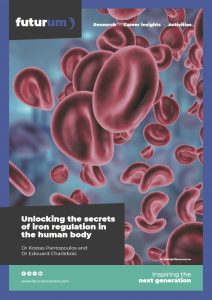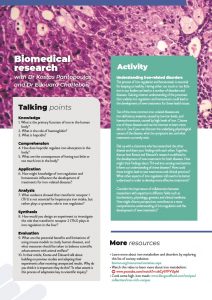Unlocking the secrets of iron regulation in the human body
Iron is crucial for many biological functions, but maintaining its balance in the body is a complex challenge. Dr Kostas Pantopoulos from McGill University, in Canada, and his former PhD student Dr Edouard Charlebois, use mouse models to investigate iron regulation and its implications for human health.
Talk like a biomedical researcher
Endothelial cells — cells that line blood vessels and regulate exchanges between the blood and the surrounding tissues and organs
Hepatocytes — the most common type of cell in the liver, with an important role in iron homeostasis
Hepcidin — a hormone that regulates the body’s ability to absorb and transport iron
Homeostasis — the process by which an organism maintains stable and balanced internal conditions
Mouse model — a laboratory mouse used to study an aspect of human physiology or disease
Systemic — relating to the whole body rather than a specific organ or cell type
Transferrin — a protein that transports iron through the bloodstream to cells that need it
Non-transferrin bound iron — a potentially toxic form of iron in the blood that is not bound to transferrin
A healthy adult human produces over 200 billion red blood cells every single day. Each of these cells contains a protein known as haemoglobin, which is essential for transporting oxygen around our bodies and keeping us alive. Producing these blood cells, and the haemoglobin contained within them, requires iron, and lots of it. This is just one of the indispensable roles that iron plays within our bodies. It is an essential element for almost all living organisms, and without it, humans would not survive.
Unfortunately, you can always have too much of a good thing. Humans are unable to expel excess iron from our bodies, and if it builds up, it can become toxic and make us ill. Balancing the iron levels in our bodies, a process known as iron homeostasis, is a delicate act, but one that is key to our survival.
Dr Kostas Pantopoulos, a biomedical researcher at McGill University, and his former PhD student Dr Edouard Charlebois, currently post-doctoral fellow at the XSeed labs, are studying the complexities of iron regulation and homeostasis. Using genetically modified mice, they are exploring the role that the liver plays in keeping our iron levels balanced.
How does iron move around the body?
Our bodies cannot make iron, so all of the iron that we need must come from our diet. This iron is absorbed in the small intestine and passes into the bloodstream where it binds to transferrin, a protein that transports it around the body to the cells that need it.
When the transferrin reaches a cell, it binds to a receptor known as transferrin receptor 1 (Tfr1). “Tfr1 provides a docking site for transferrin and is essential for iron delivery to cells; this is why it is often called the ‘cellular iron gate’,” explains Kostas.
How does the body regulate iron?
The liver plays a central role in iron regulation. Not only is it the main site of excess iron storage in the body, but it also produces the hormone hepcidin which regulates how much iron we absorb from our diets.
Hepcidin is produced by cells in the liver called hepatocytes. As iron levels in our body increase, more of it begins to be stored in the liver. Hepatocytes sense when iron levels in the liver begin to rise and produce hepcidin to prevent us from absorbing any more iron. When iron levels are low, hepatocytes stop producing hepcidin so that we can start absorbing iron again.
Kostas and Edouard experimented with genetically modified mice to investigate the role that Tfr1 plays in this process of iron regulation in the liver. “We generated mice with specific disruption of Tfr1 in hepatocytes,” explains Kostas. “Surprisingly, we observed that the mice were developing normally and did not exhibit any signs of disease.” These results show that hepatocytes are able to acquire iron without the key transferrin receptor, Tfr1.
“Nevertheless, the mice had significantly less iron stored in their livers and were unable to adjust their production of hepcidin to balance their iron levels,” adds Kostas. “The most important conclusion of this study was that Tfr1 is not essential for supplying iron to hepatocytes but rather has a ‘systemic’ function in the control of hepcidin expression and overall body iron regulation.”
In order to carry out this systemic regulation, hepatocytes need to be able to sense the amount of iron in the body. The process by which hepatocytes do this is not well understood, and is another focus of Kostas and Edouard’s research.
How do hepatocytes sense iron levels in the liver?
“Earlier work suggests that circulating iron in the bloodstream and liver iron stores stimulate hepcidin expression by different mechanisms,” says Kostas. As we absorb iron into our bloodstream, transferrin molecules fill up and become saturated. This increase in transferrin saturation is sensed by another type of receptor, transferrin receptor 2 (Tfr2), which activates hepcidin production.
“The mechanism by which increased liver iron stores induce hepcidin is more complex and is not completely understood,” says Kostas. “We know that endothelial cells in the liver secrete proteins called bone morphogenic protein 6 (BMP6) and bone morphogenic protein 2 (BMP2) which bind to receptors on hepatocytes and activate the production of hepcidin.”
Reference
https://doi.org/10.33424/FUTURUM516
Kostas and Edouard have dinner with other members of the lab.
Kostas and his lab team.
Certain foods containing high levels of iron are good to eat if you suffer from iron deficiency anaemia.
Kostas and Edouard hypothesised that the endothelial cells detect high iron levels through Tfr1. To test this hypothesis, Kostas and Edouard used genetically modified mice that had no Tfr1 on their endothelial cells to see if the mice could still regulate their iron level. “Surprisingly, these animals responded appropriately to dietary iron challenges, refuting our initial hypothesis,” says Kostas.
Using a state-of-the-art technique known as ‘single cell transcriptomics’, Kostas and Edouard continued to explore this problem. “We observed that acute intake of high dietary iron rapidly saturated transferrin, resulting in the accumulation of ‘non-transferrin bound iron’,” explains Kostas. “Our overall data suggest that BMP6 expression in endothelial cells in the liver is primarily caused by non-transferrin bound iron, rather than transferrin-bound iron.”
In other words, when our iron levels become too high, transferrin becomes saturated and cannot carry any more iron. The excess iron circulates through the bloodstream as nontransferrin bound iron, which is detected by endothelial cells in the liver. These cells then secrete BMP6 which signals nearby hepatocytes to start producing hepcidin, preventing us from absorbing any more iron from our diets.
Why is this research significant?
Understanding these processes is crucial for insights into liver function, physiology and the development of liver diseases. “The progress from basic science to clinical applications has been rapid, with significant advancements achieved in just over two decades since the discovery of hepcidin,” says Kostas. “This progress highlights the importance of foundational research in animal models to develop new diagnostic and therapeutic tools for human diseases.”
 Dr Kostas Pantopoulos
Dr Kostas Pantopoulos
Professor in the Department of Medicine, McGill University, Montreal, Canada
Senior Investigator, Lady Davis Institute for Medical Research, Montreal, Canada
Dr Edouard Charlebois
Former PhD student in Dr Pantopoulos’ lab and currently Postdoctoral Fellow, Team MFW, XSeed Labs, Biomed X Institute, Connecticut, USA
Field of research: Biomedical research
Research project: Investigating the mechanisms of iron metabolism and homeostasis using mouse models
Funder: Canadian Institutes of Health Research (CIHR)
About biomedical research
“Biomedical research encompasses a broad range of scientific disciplines and aims to explore human biology and disease at the molecular, cellular and systemic level,” says Kostas. “Understanding the molecular and physiological mechanisms underlying common or rare disorders is essential for the development of new therapies and, eventually, for the improvement of healthcare and patients’ quality of life.”
The field employs various methodologies, including the use of cell and animal models, to investigate fundamental biological processes and their implications for health and disease. While not every discovery translates directly into clinical applications, each incremental advance contributes to a growing body of knowledge that underpins major scientific breakthroughs and the development of effective medical treatments.
“It is always exciting to identify a biomedical problem, develop a hypothesis, design experiments, interpret the results and plan follow-up studies,” says Kostas. “It is also rewarding to present work at scientific conferences, publish data in scientific journals and disseminate scientific discoveries to the public.” Such efforts promote scientific dialogue and drive innovation in healthcare, ultimately enhancing patient care and quality of life globally. Biomedical research stands at the forefront of shaping the future of medicine through the continual exploration, discovery and application of scientific knowledge.
Pathway from school to biomedical researcher
Focus on biology and chemistry during high school and beyond to build a solid understanding of fundamental biological and chemical principles.
“Relevant sub-disciplines are molecular biology, cell biology, structural biology, physiology, immunology, microbiology and biochemistry,” says Kostas. “Studying in any of these areas can provide a foundation for a career in biomedical research.”
To gain essential analytical and technological skills, supplement scientific training with courses in computer science for bioinformatics, mathematics for biostatistics and physics for biomedical engineering.
Explore careers in biomedical research
“Biomedical research is a very broad term and there are several websites, societies and books focusing on various aspects,” says Kostas. “Researchers in the iron metabolism field have established the BioIron International Society for the Study of Iron in Biology and Medicine.”
Explore resources from international organisations like the American Society for Biochemistry and Molecular Biology and the European Molecular Biology Organisation. These organisations provide career guidance, networking opportunities and educational resources.
Institutions like McGill University offer summer research internships and training programmes for students interested in biomedical research. “McGill University has launched the Branches Community Outreach Program, which helps students map their paths towards post-secondary education,” says Kostas.
Meet Kostas
The subjects I liked most at school were the natural sciences. I particularly liked chemistry, so I chose to study it for my bachelor’s degree. I was blessed that my dream of exploring the world and experiencing different places came true. I grew up in Athens, Greece, and got my bachelor’s and PhD degrees in Thessaloniki, Greece. I then had my postdoctoral training in Heidelberg, Germany, and finally moved to Montreal, Canada.
My biggest motivations are scientific curiosity and a desire for discovery. I had great mentors at the early stages of my career who shaped me as a scientist. Particularly the late John Georgatsos, my PhD supervisor at the Aristotle University of Thessaloniki, and Matthias Hentze, my postdoctoral mentor at the European Molecular Biology Laboratory (EMBL) in Heidelberg, who introduced me to the world of molecular biology and cutting-edge science.
When I chose this career path, I was confident that it was right for me. The thrill of working in a lab, designing experiments and acquiring new data captivated me. My journey began during a time when the science landscape was vastly different from today. With the internet in its infancy, my exposure to the broader scientific community was limited while working in a peripheral lab during my graduate studies. This all changed during a short-term visit to EMBL, which was an eye-opener for me. Inspired by this experience, I decided to come back as a postdoc.
When I’m not working, I play classical guitar, spend time with my family and take our dog for walks. I used to play volleyball, but during the last few years my sporting activities have mostly been hiking, jogging, tennis, cross-country skiing and downhill skiing.
Kostas’ top tips
1. Take the path that you truly love and are passionate about.
2. Don’t be put off by the difficulties and the temporary disappointments down the road.
3. Set high and ambitious goals, work hard and take advantage of opportunities that come your way.
Meet Edouard
Looking back, I believe I’ve always been interested in problem solving to some degree. In school, I liked and excelled at all the STEM classes but struggled with history, art and language classes. That said, creativity and communication are incredibly important skills for scientists as finding innovative solutions is the cornerstone of progress, and we often have to ‘sell’ or explain our ideas to others.
They say fear is a great motivator. One of my greatest fears has been to end up in a job where I could not express some form of creativity or critical thinking. A career in science is very rewarding in that sense. In my current role and throughout my graduate studies, I have had the chance to collaborate with many amazing people and come up with interesting experiments to answer exciting questions.
I think the best personality trait a scientist can have is perseverance, at least when it comes to experiments. This is best described as the ability to not be discouraged by negative results and experimental failures.
The main way I like to unwind is by relaxing and chatting with my friends over voice chat. We watch a variety of TV shows together and we’re all avid video gamers, each with our own favourite genre, so we discuss and play these together as well.
Do you have a question for Kostas and Edouard?
Write it in the comments box below and Kostas and Edouard will get back to you. (Remember, researchers are very busy people, so you may have to wait a few days.)

Learn more about how our bodies produce blood and what happens when this process goes wrong:
www.futurumcareers.com/what-happens-when-our-blood-production-system-fails











0 Comments